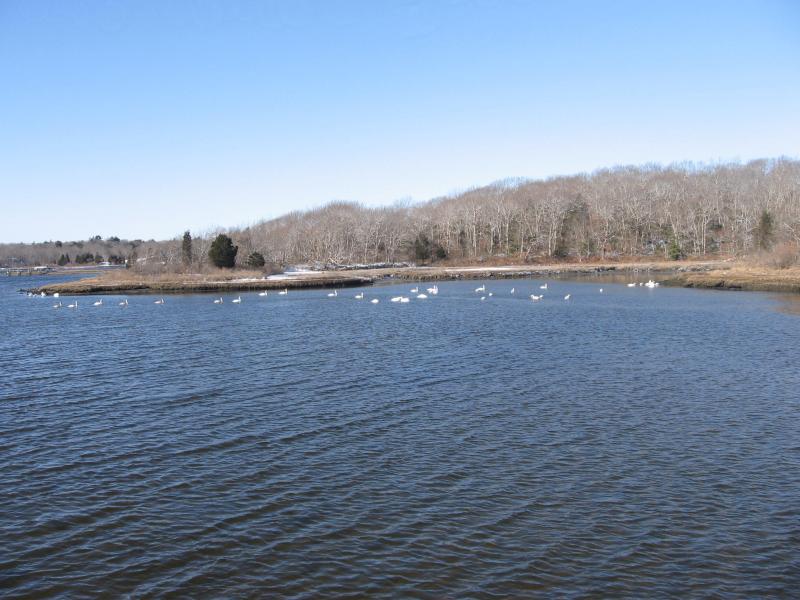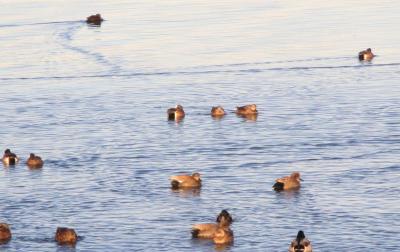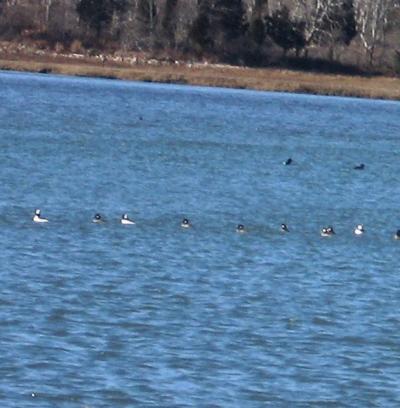Hints of Climate Change Visible in Second Count of Winter Waterfowl Survey by Lloyd Center Research Associate Jamie Bogart
The winter waterfowl survey was initially structured in 1988 to include “meteorological winter”, when the true marks of the season, snow and ice, coat the landscape. Count two of the 33rd annual winter waterfowl survey held on January 26, occurred on the heels of a recent Sunday where temperatures reached 60, and the day after pouring heavy rains, not falling snow, enveloped the region. The mid-forties early morning temperatures quickly warmed to what felt like anything but a cold winter’s day. The 8:00 a.m. high tide was average, but the heavy rains the prior day raised water levels, which meant lots of walking to locate birds in hidden, flooded coves. After a return to moderate ice coverage a year ago for January, the trend reversed again to almost no ice. In fact, with so much talk of ice relative to waterfowl, all but one of the past five January/February surveys has featured no or minimal ice on estuaries and coastal ponds.
With no significant correlation between ice and bird abundance in January, it’s difficult to use ice coverage as a predictor of waterfowl abundance. While extremely high coverage simply eliminates habitat for most species, no ice due to recent warmth can be occupied by birds leaving freshwater wetlands in much colder regions. Recent years with higher waterfowl totals had lower ice coverage, and abundance was strikingly similar. The count total for January 26 was 5,687 birds, only 73 less than last January, and only 25 less than the average of 5,662 for the past three years. Counts for January 2018-2020 have been 5,536, 5,763, and 5,687 birds respectively, for a range of variation of only 227 birds. What might explain these sustained waterfowl numbers in ice-free years?
Canada Goose abundance continues to be the driving factor influencing overall waterfowl abundance. As stated in previous writings, a thriving local population and migrants result in large winter flocks near estuaries, and the geese readily utilize the grassy buffer zones so characteristic of this rural, agrarian region. Canada Goose numbers (2,798) were nearly identical to last January (2,811), with high numbers present on the Westport River (768), Cockeast Pond (660), Nannaquaket Pond (597), and the Slocum River (239) for this count. As expected, these sites also had the highest overall waterfowl totals. While last year the rare event of a decline from December goose numbers occurred after the count was delayed a week, this year the usual trend of an increase in January numbers occurred. It’s likely geese return to their same favorite wintering habitat annually, particularly in-state birds that may disperse only short distances.
For other species, Mute Swan (290) showed a notable increase with a large flock at Briggs Marsh (207), where they often congregate, and Brant (72), which were not present last January and were mostly at lower Apponagansett Bay (56). Divers increased somewhat from last January including scaup, Bufflehead, and Red-breasted Merganser, with Nannaquaket Pond having large flocks of Bufflehead (227), and Greater Scaup (101). Other than the Westport River which combines three sections, both these divers and geese ensured that Nannaquaket Pond had the highest overall totals (1,027).
The notable decline that contributes to the overall decline from last year’s totals was for the common dabblers, American Black Duck and Mallard. Black Ducks were down considerably to 578 for this count from last year’s 1,127, Mallard from 533 to 208. Unlike diver species, many of which flock to larger, open embayments, these species may linger in smaller freshwater systems, especially Mallard, which frequent local parks with ponds. Black Ducks also inhabit hidden creeks of estuaries along the salt marsh, especially during periods of high tides, when they may be difficult to detect and numbers slightly underestimated. A notable sighting included one Ruddy duck at Round Pond for a species seen almost exclusively in December.
So are these extended January thaws that impact the waterfowl survey a blip on the screen, or are impacts of climate change a new realm of study for the winter waterfowl survey? Clearly more surveys are needed to be sure, and time will tell.













